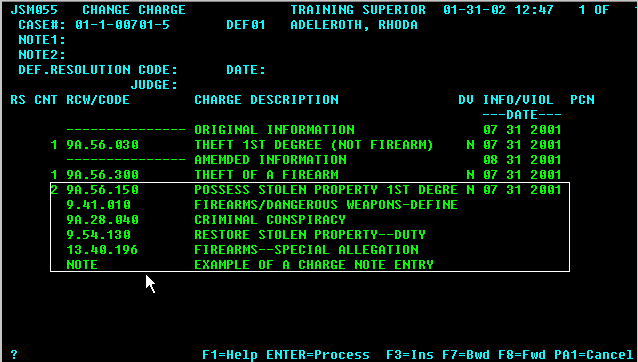

For the complete description and text of an RCW, see the Washington State Legislature's RCW Web site.
|
N |
Not an RCW offense |
|
M |
RCW Misdemeanor |
|
G |
RCW Gross Misdemeanor |
|
F |
RCW Felony |
|
C |
RCW Combination |
|
00 |
Non-Charge (See Note Below) |
|
01 |
Homicide |
|
02 |
Sex Crime |
|
03 |
Robbery |
|
04 |
Assault |
|
05 |
Burglary (discontinued 12/31/1991) |
|
06 |
Theft/Burglary |
|
07 |
Motor Vehicle Theft |
|
08 |
Controlled Substance |
|
09 |
Other Felony |
|
10 |
Misdemeanor/ Gross Misdemeanor |
|
11 |
Lower Court Appeal |
|
98 |
Deadly Weapon |
|
99 |
Definitions |
RCW Codes are used on the SCOMIS Charge screen for criminal and juvenile offender cases. For each count there can be a total of seven entries including one primary RCW from Stat Category 1 - 10, deadly weapons RCWs from Stat Category 98, definition RCWs from Stat Category 99, and one Note entry. The long description of the primary RCWs displays in SCOMIS on the Charge screen and in JIS on case history screens (DCH/ICH). The short description of the primary RCWs displays in SCOMIS on the Search Index screen.

Non-Charge Cases Stat Category 00
A non-charge case is one in which the defendant/respondent is not charged under any state criminal statutes, but which is opened for purposes such as extradition, material witness, or preliminary appearances prior to filing of an information. A non-charge has a statistical reporting code of 00 and a statistical category of N.
Local laws or ordinances (whether criminal or infraction) entered into the SCOMIS Law Table for the purpose of processing juvenile offender cases are also entered as a Non-Charge statistical category N00.
A non-charge case should not be opened to record a search warrant, wiretap authorization, or other non-respondent document(s); record these documents in the Document Indexing application.
If an information is not filed, record a Result code N for each non-charge entry, then resolve and complete the case. Any proceedings held will be counted under the non-charge category on the Caseload Report.
If an information is subsequently filed, change the Charge record to correspond to the new information including the original information filing date, the RCW(s), the DV flag, and the violation date. On the SCOMIS Basic screen, change the case filing date to the date on which the information was filed. For a juvenile offender case, change the Class code from NON to MIS, GMS, or FEL to reflect that criminal charges are to be adjudicated. The case will be counted in the Caseload Report as of the date the information is filed. Any proceedings held prior to the filing of an information will be counted under the non-charge category on the Caseload Report.
In the 2003 Legislative Session, a project was undertaken by the Justice Information Network (JIN) to reorganize criminal RCWs to eliminate multiple charges and/or penalties within a single RCW subsection. In SCOMIS, these are referred to as “combination” laws. This reorganization (which went into effect on July 1, 2004) was necessary to facilitate future data exchange projects between criminal justice agencies that require a unique law citation in order to accurately identify the penalty attached to a particular charge. This project is considered a first step towards achieving that goal.
Example:
Prior to July 1, 2004, Theft of Rental/Leased Property was codified as follows:
9A.56.096(1) contains the charge of theft of rental/leased property.
9A.56.096(4) contains three possible penalties: Felony B if the property is valued at > $1,500; Felony C if the property is valued between $250 and $1,500; and Gross Misdemeanor if the property is valued at < $250.
Prior to July 1, 2004, the SCOMIS law table had entries for 9A.56.096 and 9A.56.096(4). Both laws had statistics codes of 06-Theft and C-Combination Law.
As of July 1, 2004, this RCW is recodified (and appears on the SCOMIS law table) as follows:
9A.56.096(1) contains the charge of theft of rental/leased property.
9A.56.096(5)(a) contains the Felony B penalty.
9A.56.096(5)(b) contains the Felony C penalty.
9A.56.096(5)(c) contains the Gross Misdemeanor penalty.
In order to make use of these uniquely identified penalties for sentencing and criminal history data exchange in the future, it is important that charges be filed identifying the appropriate subsection. For example, an information could contain 9A.56.096(1) as the charge, and 9A.56.096(5)(b) as the appropriate penalty. If the information simply cites 9A.56.096 or 9A.56.096(1) there would still be no way to identify the penalty.
If the information does cite both the charge and the appropriate penalty subsection, AOC would recommend that the penalty section be entered on the SCOMIS Charge Screen as the primary charge so that, in the future, the precise penalty information can be identified. This will also transfer more accurate information to the Convicted Felon Report, avoiding some of the research that is involved when combination laws are cited.
It is important, therefore, to encourage county prosecutors to cite to the particular RCW subsection. Representatives from the Washington Association of Prosecuting Attorneys (WAPA) participated in the JIN's RCW reorganization project and are familiar with the goals of this effort.
Last Updated: 2017-08-07
Last Updated: 2017-08-07